The x86 Power Myth Busted: In-Depth Clover Trail Power Analysis
by Anand Lal Shimpi on December 24, 2012 5:00 PM ESTThe untold story of Intel's desktop (and notebook) CPU dominance after 2006 has nothing to do with novel new approaches to chip design or spending billions on keeping its army of fabs up to date. While both of those are critical components to the formula, its Intel's internal performance modeling team that plays a major role in providing targets for both the architects and fab engineers to hit. After losing face (and sales) to AMD's Athlon 64 in the early 2000s, Intel adopted a "no more surprises" policy. Intel would never again be caught off guard by a performance upset.
Over the past few years however the focus of meaningful performance has shifted. Just as important as absolute performance, is power consumption. Intel has been going through a slow waking up process over the past few years as it's been adapting to the new ultra mobile world. One of the first things to change however was the scope and focus of its internal performance modeling. User experience (quantified through high speed cameras mapping frame rates to user survey data) and power efficiency are now both incorporated into all architecture targets going forward. Building its next-generation CPU cores no longer means picking a SPECCPU performance target and working towards it, but delivering a certain user experience as well.
Intel's role in the industry has started to change. It worked very closely with Acer on bringing the W510, W700 and S7 to market. With Haswell, Intel will work even closer with its partners - going as far as to specify other, non-Intel components on the motherboard in pursuit of ultimate battery life. The pieces are beginning to fall into place, and if all goes according to Intel's plan we should start to see the fruits of its labor next year. The goal is to bring Core down to very low power levels, and to take Atom even lower. Don't underestimate the significance of Intel's 10W Ivy Bridge announcement. Although desktop and mobile Haswell will appear in mid to late Q2-2013, the exciting ultra mobile parts won't arrive until Q3. Intel's 10W Ivy Bridge will be responsible for at least bringing some more exciting form factors to market between now and then. While we're not exactly at Core-in-an-iPad level of integration, we are getting very close.
To kick off what is bound to be an exciting year, Intel made a couple of stops around the country showing off that even its existing architectures are quite power efficient. Intel carried around a pair of Windows tablets, wired up to measure power consumption at both the device and component level, to demonstrate what many of you will find obvious at this point: that Intel's 32nm Clover Trail is more power efficient than NVIDIA's Tegra 3.
We've demonstrated this in our battery life tests already. Samsung's ATIV Smart PC uses an Atom Z2760 and features a 30Wh battery with an 11.6-inch 1366x768 display. Microsoft's Surface RT uses NVIDIA's Tegra 3 powered by a 31Wh battery with a 10.6-inch, 1366x768 display. In our 2013 wireless web browsing battery life test we showed Samsung with a 17% battery life advantage, despite the 3% smaller battery. Our video playback battery life test showed a smaller advantage of 3%.

For us, the power advantage made a lot of sense. We've already proven that Intel's Atom core is faster than ARM's Cortex A9 (even four of them under Windows RT). Combine that with the fact that NVIDIA's Tegra 3 features four Cortex A9s on TSMC's 40nm G process and you get a recipe for worse battery life, all else being equal.
Intel's method of hammering this point home isn't all that unique in the industry. Rather than measuring power consumption at the application level, Intel chose to do so at the component level. This is commonly done by taking the device apart and either replacing the battery with an external power supply that you can measure, or by measuring current delivered by the battery itself. Clip the voltage input leads coming from the battery to the PCB, toss a resistor inline and measure voltage drop across the resistor to calculate power (good ol' Ohm's law).
Where Intel's power modeling gets a little more aggressive is what happens next. Measuring power at the battery gives you an idea of total platform power consumption including display, SoC, memory, network stack and everything else on the motherboard. This approach is useful for understanding how long a device will last on a single charge, but if you're a component vendor you typically care a little more about the specific power consumption of your competitors' components.
What follows is a good mixture of art and science. Intel's power engineers will take apart a competing device and probe whatever looks to be a power delivery or filtering circuit while running various workloads on the device itself. By correlating the type of workload to spikes in voltage in these circuits, you can figure out what components on a smartphone or tablet motherboard are likely responsible for delivering power to individual blocks of an SoC. Despite the high level of integration in modern mobile SoCs, the major players on the chip (e.g. CPU and GPU) tend to operate on their own independent voltage planes.
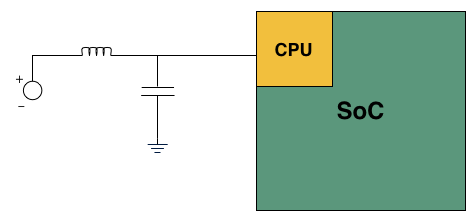
A basic LC filter
What usually happens is you'll find a standard LC filter (inductor + capacitor) supplying power to a block on the SoC. Once the right LC filter has been identified, all you need to do is lift the inductor, insert a very small resistor (2 - 20 mΩ) and measure the voltage drop across the resistor. With voltage and resistance values known, you can determine current and power. Using good external instruments you can plot power over time and now get a good idea of the power consumption of individual IP blocks within an SoC.
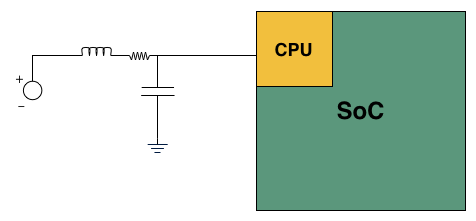
Basic LC filter modified with an inline resistor
Intel brought one of its best power engineers along with a couple of tablets and a National Instruments USB-6289 data acquisition box to demonstrate its findings. Intel brought along Microsoft's Surface RT using NVIDIA's Tegra 3, and Acer's W510 using Intel's own Atom Z2760 (Clover Trail). Both of these were retail samples running the latest software/drivers available as of 12/21/12. The Acer unit in particular featured the latest driver update from Acer (version 1.01, released on 12/18/12) which improves battery life on the tablet (remember me pointing out that the W510 seemed to have a problem that caused it to underperform in the battery life department compared to Samsung's ATIV Smart PC? it seems like this driver update fixes that problem).
I personally calibrated both displays to our usual 200 nits setting and ensured the software and configurations were as close to equal as possible. Both tablets were purchased by Intel, but I verified their performance against my own review samples and noticed no meaningful deviation. All tests and I've also attached diagrams of where Intel is measuring CPU and GPU power on the two tablets:

Microsoft Surface RT: The yellow block is where Intel measures GPU power, the orange block is where it measures CPU power
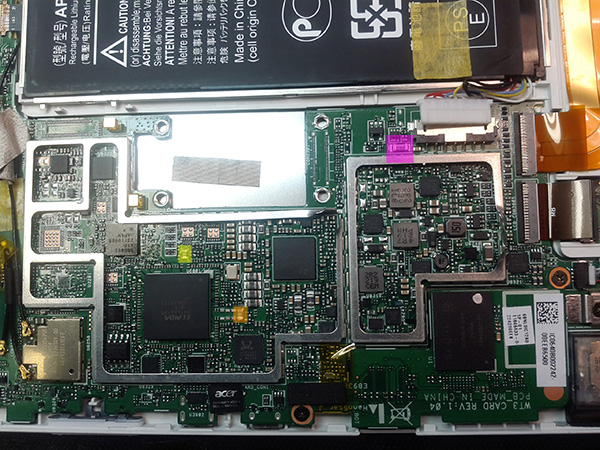
Acer's W510: The purple block is a resistor from Intel's reference design used for measuring power at the battery. Yellow and orange are inductors for GPU and CPU power delivery, respectively.
The complete setup is surprisingly mobile, even relying on a notebook to run SignalExpress for recording output from the NI data acquisition box:
Wiring up the tablets is a bit of a mess. Intel wired up far more than just CPU and GPU, depending on the device and what was easily exposed you could get power readings on the memory subsystem and things like NAND as well.
Intel only supplied the test setup, for everything you're about to see I picked and ran whatever I wanted, however I wanted. Comparing Clover Trail to Tegra 3 is nothing new, but the data I gathered is at least interesting to look at. We typically don't get to break out CPU and GPU power consumption in our tests, making this experiment a bit more illuminating.
Keep in mind that we are looking at power delivery on voltage rails that spike with CPU or GPU activity. It's not uncommon to run multiple things off of the same voltage rail. In particular, I'm not super confident in what's going on with Tegra 3's GPU rail although the CPU rails are likely fairly comparable. One last note: unlike under Android, NVIDIA doesn't use its 5th/companion core under Windows RT. Microsoft still doesn't support heterogeneous computing environments, so NVIDIA had to disable its companion core under Windows RT.


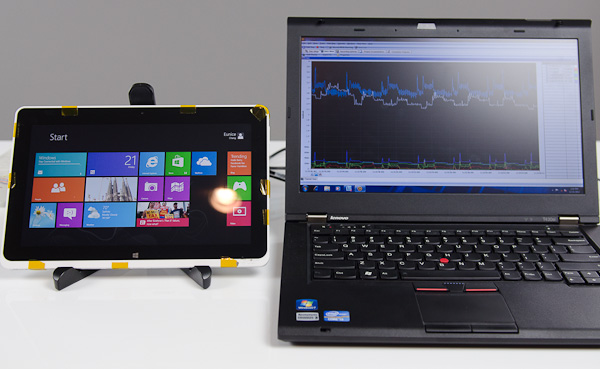
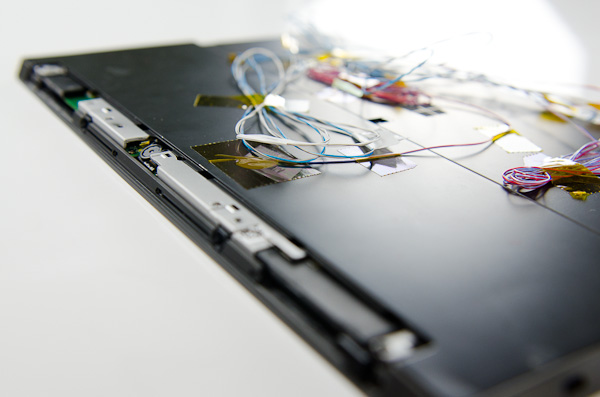
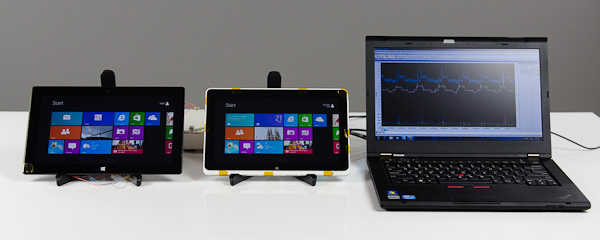














163 Comments
View All Comments
dc77gti - Tuesday, December 25, 2012 - link
Looking forward to 22nm Bay Trail-T. Hopefully Intel can get this out before 2014.That's half the battle. The other half lies with Google Android. We'll have to wait and see. With Intel's hardware might and Android's open source project, things will get more exciting.
kyuu - Wednesday, December 26, 2012 - link
*sigh* Everyone seems to have forgotten about AMD's Temash which should be out by mid-2013... hopefully. Hell, I'd even take a Hondo tablet over Clover Trail, if anyone actually made one.thebeastie - Tuesday, December 25, 2012 - link
I don't know about this.. all of a sudden the tables have turned against ARM?Mythbusters do a pretty thorough job on testing, I want them to do the same round of testing on these chips and see what THEY come up with.
Apples A6 still reams the Atom so its not really that great.
Anyway ARMs real kryptonite has been price. Intel might sell thee chips cheap as a last ditch stand one off or two off but they can't do it forever before what matters to them most falls apart.... and thats making a lot of money.
puppies - Wednesday, December 26, 2012 - link
I think most of us realise that intels biggest problem right now is that in the desktop environment (their main source of income from the public) a 3 or 4 year old chip is more than adequate for 99% of tasks that the average pc user wants to perform. Software just isn't being developed (or is there much need for it) that requires a quad core 3.5ghz cpu with turbo and HT when a 2.5ghz dual core will more than suffice.If however they can push the performance envelope of these ultra low voltage parts to a point where software starts being developed that can utilise those chips to their potential then ARM will not be a viable option for anyone who needs that performance.
Most tablet reviews state something along the lines of "it is ok for a few last minute corrections to a presentation but you might want something more powerful for when you aren't on the train/plain etc". If intel changes that to "This ultra portable tablet has enough grunt for all your word/powerpoint/excel creation needs" and ARM can't keep up then Intel becomes the required CPU for business users, intel really doesn't care about $200 tablet sales. They are generally bought as presents for kids and there just isn't the profit available that intel seems to desire.
Combine this with the fact that no company is going to want to deal with the headache of trying to sync workloads between X86 office pcs and ARM based ultra portables and intel suddenly has a reason to charge the big bucks again.
FunBunny2 - Friday, December 28, 2012 - link
I expect the reality is: for consumers, the need for anything much more than a 486 is, well, past. Not much computation outside of Excel. Pretty pixels, on the other hand...If M$ could write a yet more bloated OS, then the old Wintel symbiotic monopoly might return. Fact is, we're still where Xerox PARC put us 3 decades ago. The hardware isn't much different, save for touch, either. There was a time when PCs shipped with monochrome tubes, by default. And the OS was a command line ark.
war59312 - Wednesday, December 26, 2012 - link
Hey,This image as linked on page 5, the very last image appears to be broken:
http://images.anandtech.com/reviews/SoC/Intel/CTvT...
Thanks,
Will
Veteranv2 - Wednesday, December 26, 2012 - link
Reading this review, it makes me realize how websites are abused as a marketing gimmick.Keep this in mind:
- It is all teste on Win8.
- Win8 is primarely Win7 but with ARM support
- Windows has been optimized for X86 in any way, they just recently added support.
- Who says ARM support on Win8 is any good for ARM performance? It is compatible, but x86 has enjoyed +20 years of optimization
If anandtech would have wanted to do this right they would have used this:
- A6X or A15 ARMcores
What has anandtech proven:
- Win8 is bad for ARM
- Tegra3 on 40nm has worse power consumtion then a 32nm part
- It is a marketing tool for intel which is struggling in the tablet market and needs positive things like this
- That it cannot objectively make differences clear between architectures, cause this review has nothing to do with architectures...
A sad day for anandtech...
thebeastie - Wednesday, December 26, 2012 - link
I guess I could agree with this, Anandtech is my absolute favorite tech site for the truth but some times he just seems to be a little bit too much of an Intel fan. But alternatively I do see that he is ready to hand out credit where it is due, and Intel is all too often the company to beat.Ultimately I think his heading was a poor choice of words and is just as much appeared to be skewed towards headline grabbing as much has being an accurately balanced review.
I guess that will always be part of the game with "the press"
CeriseCogburn - Friday, January 25, 2013 - link
You guys missed the bucket of fudge, and forgot the nvidia hate.Thus the Tegra3. you've missed the bias boat, bros.
Anand got screwed on nVidia gpu's a long while back, and they AND Tom's have never forgotten the slight.
It was the (made notorious) "rebranded" nVidia 9800x, where Anand just reused another of the nVidia gpu's they had in house and adjusted the clocks and claimed they thus tested the "new" nVidia release.
The deep hatred has been seething here ever since, in every article, pumping up the amd fanboys, and only recently has that latter group somewhat receded, due to continual epic fails by amd.
powerarmour - Friday, December 28, 2012 - link
Agreed